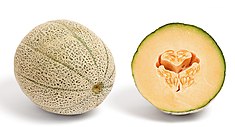| Cantaloupe | |
|---|---|
 European cantaloupe (true cantaloupe) | |
| Genus | Cucumis |
| Species | C. melo |
| Subspecies | C. melo subsp. melo |
| Cultivar group | Cantalupensis Group (incorporating Reticulatus Group[1]) |

 American Eastern cantaloupe and its cross-section | |||||||||||||||||||||||||||||||||||||||||||||||
| Nutritional value per 100 g (3.5 oz) | |||||||||||||||||||||||||||||||||||||||||||||||
|---|---|---|---|---|---|---|---|---|---|---|---|---|---|---|---|---|---|---|---|---|---|---|---|---|---|---|---|---|---|---|---|---|---|---|---|---|---|---|---|---|---|---|---|---|---|---|---|
| Energy | 141 kJ (34 kcal) | ||||||||||||||||||||||||||||||||||||||||||||||
8.16 g | |||||||||||||||||||||||||||||||||||||||||||||||
| Sugars | 7.86 g | ||||||||||||||||||||||||||||||||||||||||||||||
| Dietary fiber | 0.9 g | ||||||||||||||||||||||||||||||||||||||||||||||
0.18 g | |||||||||||||||||||||||||||||||||||||||||||||||
0.82 g | |||||||||||||||||||||||||||||||||||||||||||||||
| |||||||||||||||||||||||||||||||||||||||||||||||
| Other constituents | Quantity | ||||||||||||||||||||||||||||||||||||||||||||||
| Water | 90.2 g | ||||||||||||||||||||||||||||||||||||||||||||||
| †Percentages estimated using US recommendations for adults,[2] except for potassium, which is estimated based on expert recommendation from the National Academies.[3] | |||||||||||||||||||||||||||||||||||||||||||||||
The cantaloupe (/ˈkæntəloʊp/ KAN-tə-lohp) is a type of true melon (Cucumis melo) with sweet, aromatic, and usually orange flesh. Originally, cantaloupe refers to the true cantaloupe or European cantaloupe with non- to slightly netted and often ribbed rind. Today, it also refers to the muskmelon with strongly netted rind,[1] which is called cantaloupe in North America (hence the name American cantaloupe), rockmelon in Australia and New Zealand, and spanspek in Southern Africa. Cantaloupes range in mass from 0.5 to 5 kilograms (1 to 11 lb).
- ^ a b Pitrat, Michel (2017). "Melon Genetic Resources: Phenotypic Diversity and Horticultural Taxonomy". In Grumet, Rebecca (ed.). Genetics and Genomics of Cucurbitaceae. Plant Genetics and Genomics: Crops and Models. Vol. 20. Cham: Springer International Publishing. pp. 25–60. doi:10.1007/7397_2016_10. ISBN 978-3-319-49332-9.
- ^ United States Food and Drug Administration (2024). "Daily Value on the Nutrition and Supplement Facts Labels". FDA. Archived from the original on 27 March 2024. Retrieved 28 March 2024.
- ^ National Academies of Sciences, Engineering, and Medicine; Health and Medicine Division; Food and Nutrition Board; Committee to Review the Dietary Reference Intakes for Sodium and Potassium (2019). Oria, Maria; Harrison, Meghan; Stallings, Virginia A. (eds.). Dietary Reference Intakes for Sodium and Potassium. The National Academies Collection: Reports funded by National Institutes of Health. Washington, DC: National Academies Press (US). ISBN 978-0-309-48834-1. PMID 30844154. Archived from the original on 9 May 2024. Retrieved 21 June 2024.